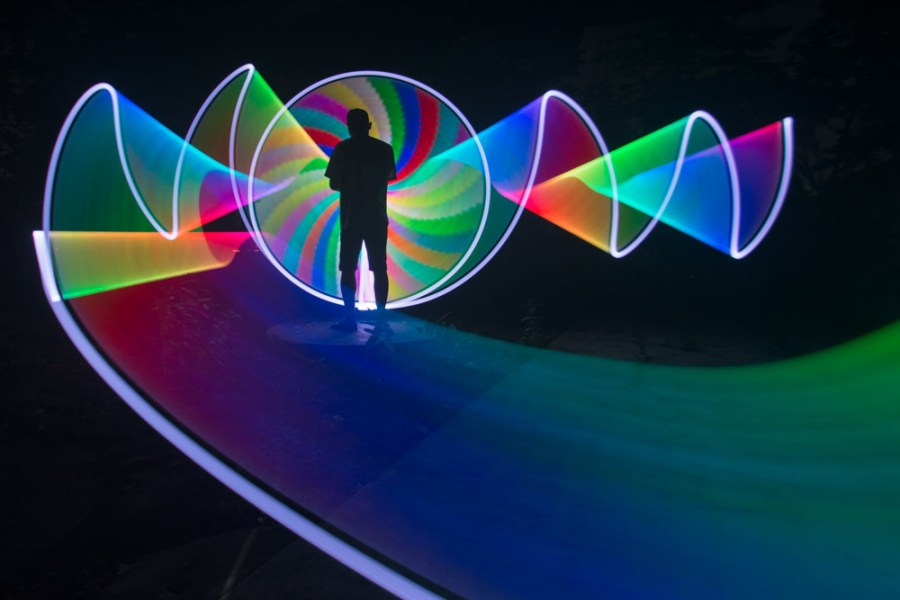Painting with light is a great way to learn more about long exposure photography, as well as be creative in different ways, letting you create cool looking photos even when you might be lacking natural light or an interesting scene to photograph. Or you can use it to light up a scene in new ways. In this guide, we’ll take you through the process and the different ways you can use light painting to make great photos and more importantly, have some fun along the way.
Welcome to the AP Improve Your Photography Series – in partnership with MPB – This series is designed to take you from the beginnings of photography, introduce different shooting skills and styles, and teach you how to grow as a photographer, so you can enjoy producing amazing photography (and video), to take you to the next level, whether that’s making money or simply mastering your art form.

Each week you’ll find a new article so make sure to come back to continue your journey, and have fun along the way, creating great images. If you’ve found these articles helpful, don’t forget to share them with people you know who may be interested in learning new photography skills. You’ll find a whole range of further articles in this series.
Painting with light is nothing new: in fact, the technique can be seen in an image dating back to 1889, when Étienne-Jules Marey and Georges Demeny attached incandescent bulbs to the joints of an assistant and made an exposure while she jumped through the air, leaving a trail of light behind her. But the idea of moving a light source during a long exposure really gained popularity in the 1930s when American artist Man Ray produced his Space Writing portrait.
Using a penlight Ray drew swirls and loops in the air, creating a seemingly random scribble. The scribble was later found to contain the artist’s signature. The years that followed saw many artists experimenting with the technique including Pablo Picasso, Henri Matisse and, much later, Jozef Sedlák. In fact, the word photography is actually an amalgamation of two Greek words: phos (light) and graphis (drawing), so it’s no surprise that the technique has gained such a following.

Writing with sparklers, light painting, Photo: Shutterstock, wibulpass – Unleash your inner Picasso and try ‘drawing’ in the air using flowing curves or jagged lines
What is painting with light?
According to Jason D. Page, artist and founder of the Light Painting Photography website (www.lightpaintingphotography.com), there are three types of light painting:
- Light Drawing, whereby a light source is used to draw in the frame
- Kinetic Light Painting, where the lights in the scene are stationary and the camera is moved
- Light Painting, where a handheld light is used to illuminate specific parts of the scene
For the purposes of this article we will be covering the first and third types, under the umbrella term ‘light painting’. Basically, light painting can be summed up as using a light-emitting device to ‘draw’ in the frame, or highlight certain elements, during a long exposure.
Finding a good subject for light painting is easy – you can effectively trace a light around any clearly defined shape, but bikes, phone boxes and cars work especially well. You can also unleash your inner Picasso and try ‘drawing’ in the air using flowing curves or jagged lines. The most important thing is to practice – your first attempt is unlikely to be your finest, but it’s almost certain to ignite a spark that will keep you fired up through the cold autumn nights.
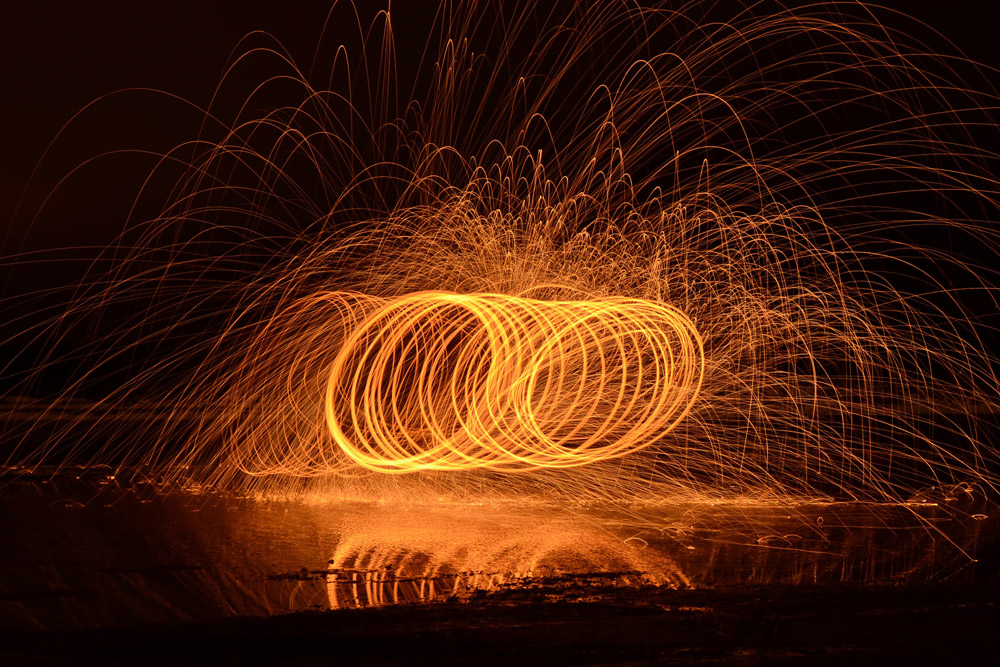
Spinning wool fireworks, long exposure, photo: Pexels, Pixabay – Torches and LED strips produce wonderfully consistent light, but fire and fireworks add a wonderful sense of energy to your work
Most people paint with light because it’s fun, and the resulting images provide a fresh take on everyday scenes, but it’s also a great way to improve your photographic technique: you will learn how your sensor performs in low light, for example, and how a change in shutter speed can alter the mood of a picture. What’s more, you will learn a great deal about prefocusing, and even setting up your tripod in the most efficient and time-saving way. What’s not to like?
What equipment do you need?
Painting with light requires merely a light source, a dark space, a camera with manually adjustable shutter speed, and a tripod – nothing more. Naturally, you can buy all kinds of adapters and accessories to perfect the technique, but to begin with it’s best to keep things simple.
For the same reason it’s preferable to shoot in a location where there is minimal ambient light. When you are using long exposures even the weakest light source can have an effect on the final exposure. But you don’t need to descend into a cave to simulate blackout conditions, you can get perfectly respectable light painting pictures in the garden, or indoors, as long as you shoot at night. Once you become more experienced you can use some sympathetically placed ambient light to illuminate attractive backgrounds while you paint away in the foreground.
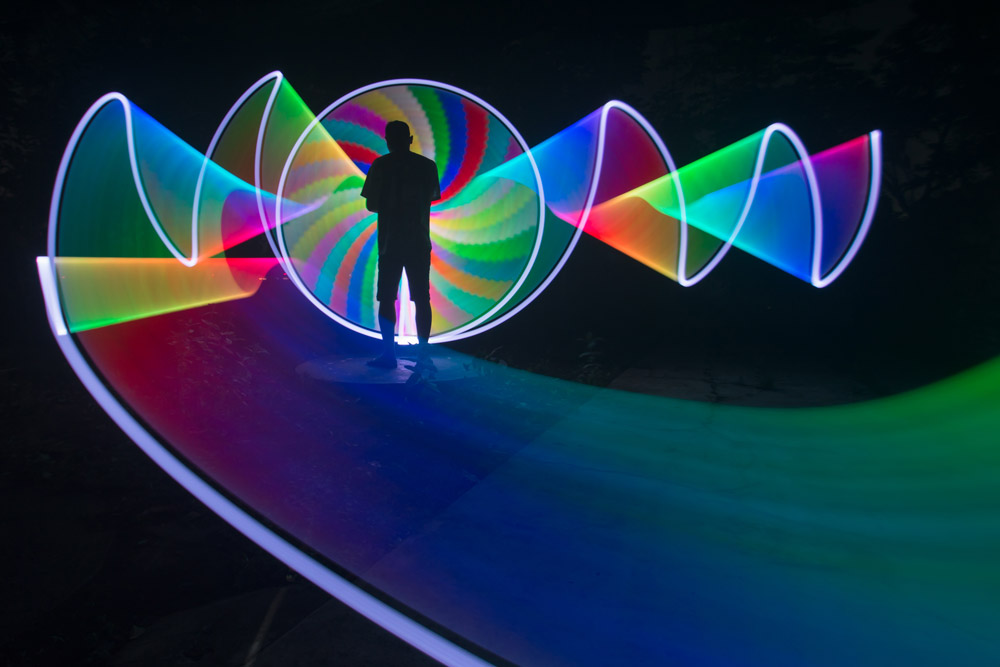
LED light stick photography – Photo Dolan Mbengi, Shutterstock
The light source you use can be anything from a sparkler to a glow stick, but LEDs are ideal because they are safe, reliable, and give out a fair amount of light. An LED torch will do the job nicely, but you can also buy LED strips that flash and change colour for under £20. LED light sticks or wands have become more and more popular over the years, and you’ll find single colour models like the Westcott Ice Light 2, colour temperature adjustable models like the Godox LC500 (Pixapro VISO500), and multi-colour models like the Godox TL30, as well as more advanced models such as the Pixelstick, there are even DIY solutions known as a ‘Digital Light Wand’. Although be warned, some of these can get quite pricey.
You can fix these strips to poles (I use an old broom handle) and move or spin them during the exposure. Nobody will see the support you’re using, they will just see the light. Another idea is to attach LED strips to bike wheels and cycle through the frame. You don’t have to spend a lot – you can even use a flashlight app on your phone (but don’t use the screen light as it’s not bright enough).
Light painting requires long exposures. Most of the time your shutter speeds will be between 10 and 20 seconds, but some can be up to an hour, so a tripod is essential. You need the camera to be as still as possible during the exposure, so try not to set the legs on wet or unstable ground, and consider hanging a weight (such as your camera bag) off the bottom of the centre column. Naturally, a tripod is best used with a remote release, or the self-timer on the camera, so make sure that you have a way of triggering the shutter without touching your equipment.
How do you paint with light?
One of the first mistakes people make when they paint with light is choosing a shutter speed too slow for the activity they have in mind. So, if you want to write your name in the air with an LED, time yourself doing it (not forgetting to add a few seconds on for walking to and from the spot you’ll be standing in if you’re not using a remote release), and use this as your guide.
It can be tempting to set a shutter speed of just a few seconds, because that’s longer than most of us are used to for our general photography, but do resist this. Painting with light takes a lot longer than you may think. Most mirrorless and DSLRs will let you to dial in up to 30 seconds, but if you need a longer exposure you will need to use the Bulb or Time mode and combine it with a remote release. Olympus and some Panasonic cameras let you use Live Bulb / Live Time and Live Composite modes so you can see the exposure develop on the screen in real time.
Once you have set the desired shutter speed, take a look at the corresponding aperture. Ideally you want the depth of field to be relatively large, so anything between f/8 and f/11 is perfect. If this isn’t what you see, you might need to adjust the ISO and rejig things, but do remember that noise can be an issue in darker areas, so keep it as low as possible (preferably ISO 100/200).
Now turn your attention to the exposure meter. When a camera is met with a predominantly dark scene it will attempt to lighten it to mid grey, so if the meter is set to zero, the image will be overexposed. In order to prevent this from happening you need to use the Exposure compensation feature and underexpose the image by one or two stops.
The next challenge is focusing. In order to work efficiently, autofocus systems need contrast, detail and light – three things that are distinctly lacking when you’re practising this technique. As a result, it can be a good idea to prefocus – try asking someone to stand where you plan to be, and use the AF-assist lamp to give your autofocus system the best chance of locking on. Failing that you may need to focus manually. What you don’t want is for the camera to try to obtain focus during the exposure, so use the AF-S mode to make sure that it focuses once, and then stops.
Light painting is rewarding, but it takes time, and requires a willingness to experiment. If your first attempt lacks spark, don’t be discouraged – stick with it and you’ll soon be hooked.
Light painting accessories
If you decide to specialise in light painting you might like to invest in one of the following…
Brushes
Try the Light Painting Brushes System from Light Painting Photography (www.lightpaintingphotography.com). It allows you to connect almost any light-emitting device (such as a torch) to almost any light modifier (such as a brush).
Fireworks
Try using fountains, Catherine wheels and Roman candles in your photography, and for fun with kids on bonfire night, the simple sparkler can be fun.
Glow sticks
There are two main types of glow stick: chemical and LED. The first type can be used only once, and they aren’t particularly environmentally friendly, while the second type is battery operated and can be used countless times, to colour a scene, create shapes etc.
Here, a Pixelstick was used to paint a rainbow pattern above a bridge to give the image greater impact, Photo: Michael Topham
Light swords
Ranging from relatively cheap, light swords (also known as light wands or lightsabers) can be used to make shapes, create light trails, or add colour to a scene, or for more advanced options, you can spend hundreds of pounds on products like the Pixelstick.
Poi balls
Swinging weighted balls is a performance art in New Zealand, but try the modern version of these props for light painting. Poi balls can create countless patterns and designs.
A quick word about colour
Selecting an appropriate White Balance for your light painting picture is mostly down to trial and error. Your best bet is to shoot raw and experiment in post. If you prefer your images to be perfect straight out of the camera, remember that different light sources have different colour temperatures – as a rule, LEDs emit cooler light than incandescent bulbs, for example. If you shoot raw you can play around with colours after shooting. If you want to add colour saturation without much effort, then look for a Vivid colour profile on your camera.
Step by step: Painting with light using your camera
Step one

Set the camera on a tripod. Time how long it takes to carry out the planned activity (drawing your name in the air, for example). Use this figure to decide on a shutter speed.
Step two
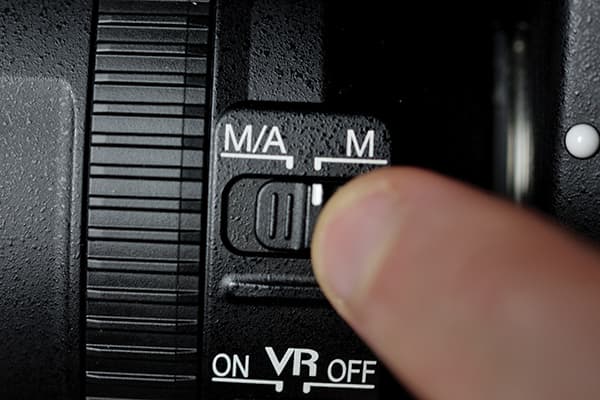
Switch the lens to Manual focus, and use the LCD screen to prefocus the lens on the spot where you will be standing – if possible ask someone to stand in for you.
Step three
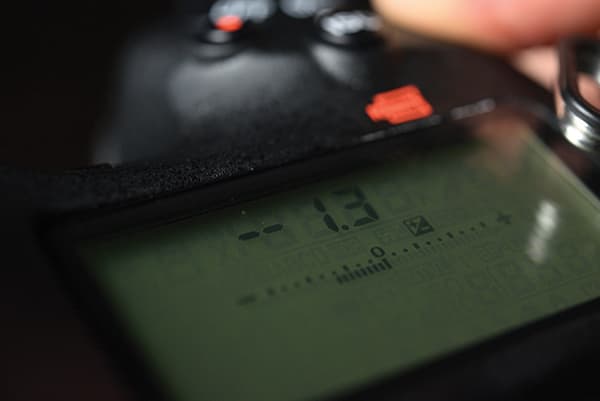
When faced with a predominantly dark scene, the camera will often overexpose the picture, so use Exposure compensation (EV) and dial in a few stops of underexposure.
Step four

Trigger the shutter using the self-timer, and move into position. Alternatively, move into position and use a remote release to trigger the shutter.
Step five
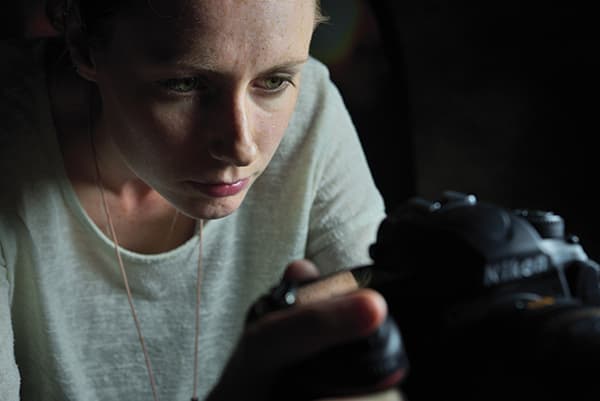
Carry out your painting, and then return to the camera to review the results. Don’t be disheartened if you don’t get the shot first time.
For more on light painting, have a look at our guide to light painting – to create artistic portraits.
Featured image: Photo Dolan Mbengi, Shutterstock
Tune in next week, for the next article in the series of the AP Improve Your Photography Series – in partnership with MPB.
- Part 1: Beginners guide to different camera types.
- Part 2: Beginners guide to different lens types.
- Part 3: Beginners guide to using a camera taking photos.
- Part 4: Beginners guide to Exposure, aperture, shutter, ISO, and metering.
- Part 5: Understanding white balance settings and colour
- Part 6: 10 essential cameras accessories for beginners
- Part 7: Beginners guide to the Art of photography and composition
- Part 8: Beginners guide to Photoshop Elements and editing photos
- Part 9: Beginners guide to Portrait Photography
- Part 10: Beginners guide to Macro Photography
- Part 11: Beginners guide to Street Photography
- Part 12: Beginners guide to Landscape Photography
- Part 13: How to shoot Action and Sports Photography
- Part 14: How to shoot wildlife photography
- Part 15: Raw vs JPEG – Pros and cons
- Part 16: How to create stunning black and white images
- Part 17: How to photograph events and music
- Part 18: Pet photography – how to photograph pets
- Part 19: The ultimate guide to flash photography
- Part 20: The ultimate guide to tripods
Find the latest Improve Your Photography articles here.

